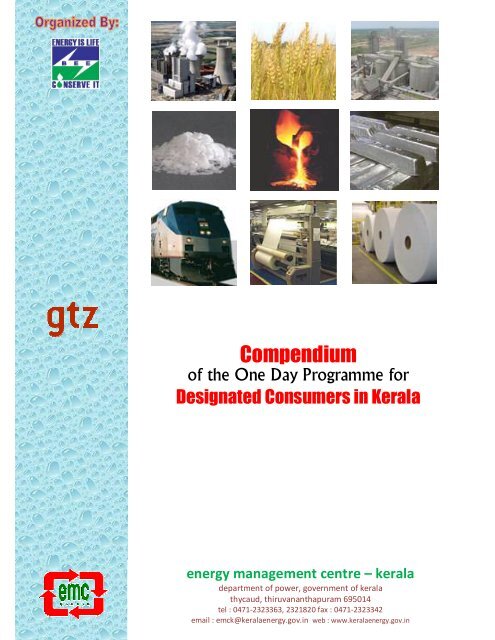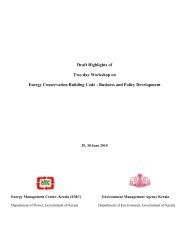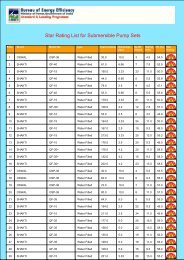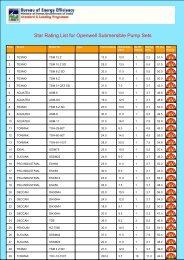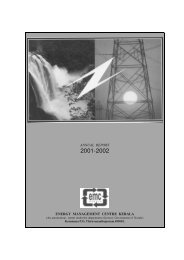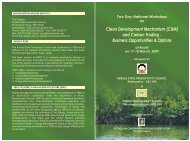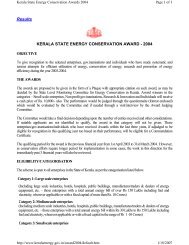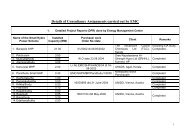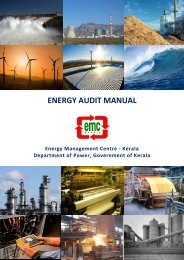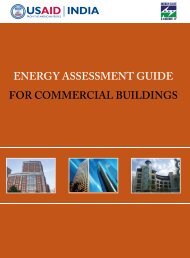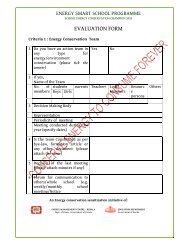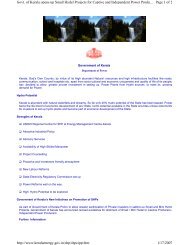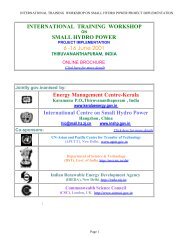Compendium for DC Programme Feb 2009 - Energy Management ...
Compendium for DC Programme Feb 2009 - Energy Management ...
Compendium for DC Programme Feb 2009 - Energy Management ...
You also want an ePaper? Increase the reach of your titles
YUMPU automatically turns print PDFs into web optimized ePapers that Google loves.
#<br />
<br />
<br />
<br />
! !!! ! " # ! !!<br />
$ %% & %%%
Registration: 09.30 - 10.00<br />
Introductory Address EMC 10.00 - 10.15<br />
Tea Break 10.15 - 10.30<br />
EC Act 2001, Role of <strong>DC</strong> , Filings;<br />
International Experience.<br />
Dr. Rudolf Rouch, GtZ<br />
10.30 - 12.30<br />
Lunch 12.30 - 01.30<br />
EE &EC , Audit Methodology, Best<br />
Practices among <strong>DC</strong>s<br />
Mr. K.K.Chakarvarti, GtZ<br />
13.30 - 15.45<br />
Tea Break 15.45 - 16.00<br />
<strong>DC</strong>s Expectation/Presentation from<br />
BEE/ SDA - Interactive Session<br />
GtZ/EMC<br />
16.00 - 1700<br />
! "<br />
"# #$% <br />
<br />
!"#<br />
$ % &'((#<br />
) * % &'((#<br />
+ , % &'((#<br />
- , % &'((#<br />
. * % &'((#<br />
/ , %(<br />
0 1 2(#'( 2(#<br />
3 ('##( 2(#
&'()*+,(-&..+<br />
<br />
<strong>Energy</strong> <strong>Management</strong> Centre (EMC)-Kerala as part of SDA activity conducted the<br />
training programme <strong>for</strong> designated consumers <strong>for</strong> annual reporting of <strong>Energy</strong> data in<br />
the State at Riviera Suite, Cochin on 3 rd of <strong>Feb</strong>ruary <strong>2009</strong>. The programme was<br />
devised <strong>for</strong> a knowledge transfer on EC Act 2001, Role of <strong>DC</strong> , E Filings;<br />
International Experience in E fillings and best practices in the respective industries;<br />
EE &EC , Audit Methodology, Best Practices among <strong>DC</strong>s. Delegates from 7 sectors<br />
attended the programme.<br />
Mr. Rudolf Rouch, gtz ,Manager IGEN- had a session on “EC Act 2001, Role of <strong>DC</strong><br />
, Filings; International Experience.” and Mr. K.K.Chakarvarti, gtz - Senior<br />
<strong>Programme</strong> Specialist had a session on ” EE &EC , Audit Methodology, Best<br />
Practices among <strong>DC</strong>s” .<br />
Delegates from different sectors had presentation on best practices on energy<br />
conservation at their industries (i.e. about industries <strong>Energy</strong> policies, <strong>Energy</strong><br />
<strong>Management</strong> System, <strong>Energy</strong> Conservation Achievements, <strong>Energy</strong> Audits / Studies<br />
Co-ordinated, Major <strong>Energy</strong> Conservation Schemes, Renewable <strong>Energy</strong> Front<br />
Initiatives ,Strategic Em Plan For The Future) .The <strong>Programme</strong> concluded with an<br />
interactive session with representatives of EMC and gtz. Mr. K K Chakarvati (Senior<br />
<strong>Programme</strong> Specialist, IGEN) and Mr. Rudolf Rouch (Manager IGEN) of gtz shared<br />
their experience with the participants
SREEKUMARY<br />
Sr Manager (<strong>Energy</strong>)<br />
Hindustan Newsprint Limited, Kerala<br />
PRESENTATION BY<br />
BEST PRACTICES ON ENERGY CONSERVATION AT<br />
HINDUSTAN NEWSPRINT LIMITED, KERALA<br />
<strong>Energy</strong> <strong>Management</strong> Structure<br />
Periodic<br />
Reviews<br />
MD<br />
GM(Works)<br />
Chairman- EM Cell<br />
<strong>Energy</strong> <strong>Management</strong> Cell<br />
Designated <strong>Energy</strong><br />
Manager<br />
Maintenance Managers<br />
HNL- <strong>Energy</strong> Policy<br />
• Create awareness among all employees to conserve energy and natural resources.<br />
• Monitor closely and control consumption of various <strong>for</strong>ms of energy through an<br />
effective energy management system.<br />
• Optimize the ratio of grid to captive power.<br />
• Reduce specific energy consumption.<br />
• Upgrade technology and improve efficiency of equipment and process.<br />
• Enhance efficiency of steam generation.<br />
• Reduce coal consumption by utilization of non- conventional fuels <strong>for</strong> steam generation.<br />
• Carry out external energy audits periodically to identify areas <strong>for</strong> continual improvement.
Training <strong>for</strong> 100 % Technical staff<br />
• EC Act -2001<br />
• On going <strong>Energy</strong> Conservation schemes.<br />
• Latest Technologies <strong>for</strong> <strong>Energy</strong> Efficiency improvement.<br />
• Brain storming sessions on identifying new avenues.<br />
Focus on Employee participation<br />
• Suggestion Schemes, Interactive Task Forces.<br />
• <strong>Energy</strong> Conservation Week.<br />
• <strong>Energy</strong> Quiz, Technical Sessions.<br />
• Campaign among colony occupants.<br />
<strong>Energy</strong> <strong>Management</strong> System Tools<br />
• Centralized <strong>Energy</strong> Monitoring System<br />
- Enercon eLAN<br />
• Integrated <strong>Management</strong> In<strong>for</strong>mation System<br />
- ERP (BaaN IV)<br />
• Integrated Process Automation<br />
- <strong>DC</strong>S<br />
<strong>Energy</strong> Conservation Achievements<br />
Specific Electrical <strong>Energy</strong>:<br />
kWh/ MT of Newsprint<br />
Specific Thermal <strong>Energy</strong>:<br />
M KCal/MT of Newsprint<br />
1865<br />
1749<br />
1653<br />
1599<br />
14%<br />
4.183<br />
4.103<br />
3.904<br />
3.75<br />
2004-05 2005-06 2006-07 2007-08<br />
2004-05 2005-06 2006-07 2007-08<br />
In ve s t m e n t E n e r g y S a vi n g C o s t S a vin g<br />
R s L a c s L a k h k W h M T o f C o a l R s L a c s<br />
2 0 0 4 - 0 5 3 5 6 9 9 3 8 0 4 4 4 2<br />
2 0 0 5 - 0 6 3 7 1 8 4 4 6 7 8 3 3 6<br />
2 0 0 6 - 0 7 7 0 8 5 3 2 9 3 3 4 5<br />
2 0 0 7 - 0 8 6 2 5 1 3 5 6 0 2 1 2<br />
<strong>Energy</strong> Audits / Studies Co-ordinated<br />
• <strong>Energy</strong> Conservation Survey in Pumps & Fans by Sri KS Raghavan, Project Consultant.<br />
• <strong>Energy</strong> Audit in Compressed Air System by M/s IR.<br />
• Comprehensive <strong>Energy</strong> Audit by M/s CII.
Major <strong>Energy</strong> Conservation Schemes<br />
(1) Variable Frequency Drives <strong>for</strong><br />
91 Pumps/Fans in 3 Phases<br />
Phase<br />
<strong>Energy</strong> Conservation Scheme : Compressed Air System<br />
Equipment: Single Centrifugal Compressor- 6400m 3 /hr, 650KW<br />
Background: Air System audit conducted through M/s Ingersoll Rand.<br />
Re-orientation of Air Distribution Network to reduce pressure drop.<br />
Result:<br />
Compressor Discharge Air Pressure Setting could be reduced from 7 to 5.7 kg/sq cm.<br />
Daily <strong>Energy</strong> Reduced from 14,500 to 12,000 units (Saving:104 KW)<br />
Annual <strong>Energy</strong> saving: 8.5 Lakhs.<br />
<strong>Energy</strong> Cost Saving: Rs 34 Lakhs.<br />
Investment: Rs 2,00,000<br />
Innovative Schemes<br />
No. of<br />
VFDs<br />
Invest. Rs<br />
Lakhs<br />
1.Optimisation of Patterns of Refining Segments , leading to 2 Stage Refining, instead of 3<br />
stage, in CMP plant<br />
Power Saving: 1350 KW<br />
• Annual <strong>Energy</strong> Saving: 75.67 Lakh kWh<br />
• Annual <strong>Energy</strong> Cost Saving: Rs 227 Lakhs.<br />
Investment: NIL<br />
2. Avoided extra refining of CMP pulp in Paper Machine plant by stopping 2 nos 400KW<br />
Refiners:<br />
Power Saving: 290 KW<br />
<strong>Energy</strong> Saving: 24.5 Lakh KWh<br />
<strong>Energy</strong> Cost Saving: Rs 73 Lakhs<br />
Power<br />
Saving: KW<br />
Annual<br />
<strong>Energy</strong><br />
Saving<br />
Lakh<br />
kWh<br />
Cost<br />
Saving:<br />
Rs Lakhs<br />
Year<br />
I 14 95 344 29 101 2004-05<br />
II 31 152 556 38 133 2004-05<br />
III 46 132 510 28 97 2005-06<br />
Total 91 379 1410 95 331
Major <strong>Energy</strong> Conservation Schemes.<br />
• <strong>Energy</strong> Efficient Pumps<br />
• All the 26 Dynodrives replaced with EE motors & VFDs<br />
• <strong>Energy</strong> Efficient Impeller <strong>for</strong> Agitator<br />
• <strong>Energy</strong> Efficient Aerators<br />
• Speed Control of Agitators using VFDs<br />
• <strong>Energy</strong> efficient Motors<br />
• <strong>Energy</strong> Efficient Indication Lamps using LEDs<br />
• Installation of Thermo compressor <strong>for</strong> steam saving in Paper M/c.<br />
Renewable <strong>Energy</strong> Front Initiatives:-<br />
• Solar Lighting <strong>for</strong> Factory Main gate lights<br />
• Solar water heaters <strong>for</strong> Guest House, Officers’ Hostel & 4 Residential Quarters.<br />
• 1 Cub M Biogas Plant <strong>for</strong> Sr Officers’ Hostel<br />
• 10 Cub M Biogas Plant <strong>for</strong> Factory Canteen<br />
Plans Ahead!<br />
Scheme<br />
Repalce 5 nos low efficiency pumps in Pulp mills<br />
by energy efficient pumps<br />
Anticipated<br />
Savings:<br />
Lakh kWh<br />
Saving:<br />
Rs Lakhs<br />
Invest<br />
ment<br />
planne<br />
d<br />
Project Start &<br />
Completion<br />
year<br />
2.74 9.6 17.75 November 2007,<br />
March <strong>2009</strong><br />
Optimize operation of Reject dilution pump 6.49 22.72 4 April 2008,<br />
March <strong>2009</strong><br />
Reduce seal water inlet temperature and improve<br />
the per<strong>for</strong>mance of the vacuum pumps<br />
3.09 10.8 6 April 2008,<br />
March <strong>2009</strong><br />
Replace existing DM Water Booster pump with<br />
energy efficient pump<br />
Optimise the operation of river water pumping<br />
system using EE pump<br />
Replace the existing ETP Dilution pump with<br />
correct head pump<br />
0.43 1.5 2.88 October 2007,<br />
August 2008<br />
1.54 5.4 10 October 2007,<br />
March <strong>2009</strong><br />
0.34 1.2 1.5 November 2007,<br />
March <strong>2009</strong><br />
Install VFD to De-superheating pump 0.3 1.06 1 October 2007,<br />
December 2008<br />
Optimise the operation of Mill water pumping<br />
system using EE pump<br />
Replace the existing Recovery Boiler FD fan with<br />
energy efficient fan<br />
Optimise the operation of power bilers using<br />
energy efficient FD fan system<br />
1.93 6.75 10 October 2007,<br />
March <strong>2009</strong><br />
0.55 1.92 3 November<br />
2007, March<br />
<strong>2009</strong><br />
3.43 12 20 July 2008,<br />
December <strong>2009</strong><br />
Optimise the oxygen percentage levels in power<br />
boilers<br />
1750 MT<br />
Coal<br />
52.23 10 October 2007,<br />
December <strong>2009</strong>.
PRESENTATION BY<br />
Noorul Hassan. M<br />
Malabar Cements Ltd.<br />
Cement Grinding Unit, Cherthala<br />
<br />
<br />
BEST PRACTICES ON ENERGY CONSERVATION AT<br />
MALABAR CEMENTS LTD.CEMENT GRINDING UNIT, CHERTHALA<br />
Highlights of Achievements<br />
• Commissioning of Walayar Plant – 02.02.1984<br />
• Kerala State Pollution Control Award – 1990 - 1991<br />
• Secured 1st State award <strong>for</strong> <strong>Energy</strong> Conservation - 1992<br />
• VSSC Rolling Trophy <strong>for</strong> Safety measure - 1994 & 1995<br />
• Company obtained ISO : 9002 certification – Nov 1996<br />
• Kiln automation with Fuzzy Logic Expert – Nov 1997<br />
• NCBM National Award <strong>for</strong> the Best improvement in <strong>Energy</strong> - 1998<br />
• Commissioning of 600 TPD Grinding Unit – 07.08.2003<br />
• Introduced SAP – ERP System – 01.08.2007<br />
<strong>Energy</strong> Policy<br />
AIM:<br />
To optimally utilize various <strong>for</strong>ms of <strong>Energy</strong> (Fuel & Power) in a cost effective manner<br />
to ensure conservation of energy resource.<br />
Reduce specific energy consumption by identifying areas of energy saving potential in<br />
the process.<br />
Set energy consumption targets and monitor continuously.<br />
Involve all the employees to work towards progressive improvement of targets of energy<br />
consumption.<br />
Promote awareness towards energy conservation.<br />
Implement innovative ideas <strong>for</strong> modification, improvement and up gradation of the<br />
equipment & process <strong>for</strong> optimizing energy consumption.
<strong>Energy</strong> <strong>Management</strong> System<br />
<br />
<br />
<br />
<br />
<br />
<br />
!"# <br />
<br />
# <br />
Specific Power Consumption<br />
$ %& <br />
KWh / T<br />
40<br />
39<br />
38<br />
37<br />
36<br />
35<br />
34<br />
39.5<br />
38.62<br />
36.28<br />
2005-06 2006-07 2007-08<br />
year<br />
KWh /T
Best Practices - <strong>Energy</strong> Conservation Summary of Savings<br />
<br />
<br />
Sl.<br />
No<br />
Section<br />
Annual Saving<br />
Lakhs KWh<br />
Annual<br />
Savings Rs.<br />
Lacks<br />
Investment<br />
Rs. In<br />
Lacks<br />
1<br />
Contract Demand<br />
Reduction<br />
3452 KVA<br />
9.32<br />
NIL<br />
2<br />
Raw Material Handling<br />
0.27<br />
1.08<br />
NIL<br />
3<br />
Cement Mill Section<br />
5.08<br />
20.42<br />
7.25<br />
4<br />
Compressor & Pumps<br />
0.57<br />
2.28<br />
NIL<br />
5<br />
Lighting<br />
0.4<br />
1.3<br />
0.0470<br />
TOTAL<br />
6.32<br />
34.3<br />
7.2970<br />
Best Practices - Cement Mill<br />
<br />
+<br />
* <br />
*)&<br />
"<br />
#<br />
'&<br />
()<br />
"<br />
#<br />
<br />
'&<br />
# <br />
<br />
'&<br />
1<br />
Reduction of Contract<br />
Demand<br />
Reduced CD from 3000<br />
to 2500 KVA on<br />
15.05.2007<br />
3452<br />
KVA<br />
9.32<br />
NIL<br />
2<br />
Installation of VVVF drive<br />
<strong>for</strong> Recirculation Fan –<br />
132 KW.<br />
Power Saving – 33 KW /<br />
Hr<br />
1.98<br />
7.92<br />
5.0<br />
3<br />
Installation of VVVF drive<br />
<strong>for</strong> Mill Vent Fan – 55 KW.<br />
Power Saving – 22 KW /<br />
Hr<br />
1.32<br />
5.28<br />
2.25<br />
4<br />
Reduction in idle running<br />
of Belt No. 491 DP1 in<br />
RMS.<br />
On/Off control by<br />
providing interlocking in<br />
PLC<br />
0.16<br />
0.64<br />
NIL<br />
5<br />
Reduction in idle running<br />
of Belt No. 491 BC1 by<br />
providing no-material<br />
interlocking.<br />
Control system<br />
interlocking provided in<br />
PLC<br />
0.11<br />
0.44<br />
NIL
Sl.<br />
No<br />
Project Description<br />
Details of Project Work<br />
Annual<br />
Saving<br />
Lakhs<br />
KWh<br />
Annual<br />
Saving<br />
Rs.<br />
Lacks<br />
Investment<br />
Rs. In Lacks<br />
6<br />
Removed 611 FN2 Bag<br />
Filter Fan 11 KW.<br />
Modified the Bag Filter<br />
Fan Line of Fly Ash<br />
Feeding to Mill Vent Fan<br />
– 55 KW<br />
0.66<br />
2.64<br />
NIL<br />
7<br />
Removal of one 11 KW<br />
water pump in cooling<br />
water pump house.<br />
Redesign the water circuit<br />
& make energy efficient.<br />
0.495<br />
1.98<br />
NIL<br />
8<br />
Automation of<br />
Compressor Governing<br />
System<br />
Reduction of Loading<br />
Time of Compressor and<br />
<strong>Energy</strong> Saving.<br />
0.075<br />
0.30<br />
NIL<br />
9<br />
Combined two Feed Belts<br />
and removed one Drive –<br />
11 KW<br />
Combined two short belt<br />
conveyors and removed<br />
one Motor – 11 KW<br />
0.66<br />
2.66<br />
NIL<br />
10<br />
Study & optimize Bag<br />
Filter Purging Time &<br />
reduction in the DP across<br />
the filters.<br />
Reduction in consumption<br />
of compressed air – 177<br />
mtr 3 / Hr<br />
0.46<br />
1.84<br />
NIL<br />
BEST PRACTICES - Lighting<br />
Sl.<br />
No<br />
Project Description<br />
Details of Project Work<br />
Annual<br />
Saving<br />
Lakhs<br />
KWh<br />
Annual<br />
Saving<br />
Rs.<br />
Lacks<br />
Investment<br />
Rs. In<br />
Lacks<br />
1<br />
Conversion of 250 W<br />
HPMV lighting fixtures to<br />
125 W MH fixture.<br />
Optimize lighting system<br />
design<br />
0.05<br />
0.175<br />
NIL<br />
2<br />
Conversion of 125 W<br />
HPMV lamps to 70 W MH<br />
lamps.<br />
Retrofitting mercury<br />
vapour lamps with MH<br />
lamps<br />
0.29<br />
0.939<br />
0.0225<br />
3<br />
Removal of unwanted 250<br />
W lighting fittings in Clinker<br />
Storage Area<br />
Power Saving 7.5 KW /<br />
Day<br />
0.03<br />
0.09<br />
NIL<br />
4<br />
Reduction in lighting<br />
consumption by installing<br />
energy saving tube-lights.<br />
Using energy efficient<br />
tube lights<br />
0.01<br />
0.016<br />
0.0245<br />
5<br />
Rearranged Lighting<br />
Control floor wise.<br />
Provided separate control<br />
Floor wise to reduce<br />
consumption.<br />
0.02<br />
0.08<br />
NIL
PRESENTATION BY<br />
K.Fazal Mohamed, Sr.Supdt. (MTP/EEMG)<br />
P.Kannan, Dy.Supdt. (EEMG)<br />
Rajiv Gandhi Combined Cycle Power Project Kayamkulam<br />
Best Practices in RGCCPP
1.Lubrication Oil System Audit<br />
Scope<br />
<br />
<br />
<br />
Analysis of past records of oil consumption patterns<br />
A walk down site visit of all relevant areas along with respective area maintenance<br />
engineer<br />
To identify, attend and arrest lub. Oil leakages<br />
Savings<br />
<br />
<br />
Estimated savings by arresting the major quantified leak areas is between Rs. 33000 to<br />
45000 per annum<br />
The major leaks were attended during the Major overhauls<br />
2.APC Audit<br />
Electrical Research & Development Association (ERDA) has conducted the APC audit<br />
Boiler Feed Water Pumps<br />
Condensate Extraction Pumps<br />
CPHRC Pumps<br />
CW Pumps, Cooling Tower and auxiliaries (WHRB & STG)<br />
GT Module Cooling Systems and auxiliaries (Gas Turbine)<br />
ACW & DMCW Pumps<br />
Air Compressors<br />
APC-Savings Potential<br />
<br />
<br />
<br />
<br />
<br />
<br />
<br />
<br />
<br />
<br />
" <br />
#$<br />
<br />
" $'<br />
" #$<br />
<br />
" <br />
$"($#$<br />
* $++, <br />
-. $' " + /<br />
<br />
&<br />
" <br />
<br />
) 0 $1"<br />
<br />
! " <br />
$' " <br />
<br />
<br />
<br />
!<br />
"<br />
<br />
#$<br />
# <br />
<br />
<br />
<br />
! <br />
%& % !<br />
% <br />
)% % <br />
&* %% <br />
* % <br />
% % )*<br />
) % *
3. GT Compressor and Open Cycle Efficiency<br />
Open Cycle Efficiency Table<br />
<br />
<br />
UNIT Last audit 19/03/07 Present audit 25/01/08<br />
GT # 1 27.71 27.46<br />
GT # 2 28.06 27.99<br />
Compressor Efficiency Table<br />
UNIT Last audit 19/03/07 Present audit 25/01/08<br />
GT # 1 91.32 90.05<br />
GT # 2 92.58 92.45<br />
4. Off Line Water wash<br />
Unit<br />
Offline WW<br />
GT#1 03/03/08, 18/09/08<br />
GT#2 21/03/08, 27/09/08<br />
<br />
<br />
<br />
<br />
<br />
Each Offline wash yields the improvement of 3 MW in output<br />
Improvement in open cycle heat rate : 20kCal/kwh<br />
Improvement in Combined cycle heat rate : 5kCal/kwh<br />
Saving of 48 MT of naphtha equivalent<br />
Total savings (Annual): Rs.28 lacs<br />
5. On Line Water wash<br />
<br />
<br />
<br />
<br />
<br />
<br />
<br />
On line water wash system was installed in GT#1<br />
Frequency of Online water wash and Off line water wash were<br />
optimized based on cost benefit analysis<br />
Water wash is being carried out every alternative day<br />
GT#2 Compressor efficiency is able to sustain <strong>for</strong> longer<br />
duration because of Online Water Wash<br />
Output of GT#2 is 3 MW (Average) more than GT#1<br />
<strong>Energy</strong> Saved : 1.5 Kcals/kwh<br />
Savings is Rs. 87.7 Lacs
6. HRSG Audit<br />
Recommendations<br />
Thermal efficiency HRSG#1 : 82.04 %<br />
HRSG#2 : 81.62 %<br />
Design : 82.42 %<br />
Flue Gas temperature at CPH outlet :<br />
HRSG#1 : 124.1 OC<br />
HRSG#2 : 126.6 OC<br />
Design : 120.3 OC<br />
Heat Carried Away by Flue Gas: HRSG#1 : 1.47 MW<br />
HRSG#2 : 2.44MW<br />
Hot spots (HRSG#1-31 and HRSG#2-22) were identified and recorded through<br />
Thermo Vision camera<br />
Periodical thermo-vision survey to be included in PM
7. Other Measures<br />
<br />
<br />
<br />
<br />
<br />
<br />
<br />
<br />
WI flow is maintained in such a way that Nox will be nearer to 100 ppm<br />
Occupancy Sensor Installation<br />
Replacement of 40 W TL with 36 W FL<br />
Replacement of Indicators with LED indicators<br />
Solar Panel installation in Canteen and Guest House<br />
Summer Cooling in Naphtha Tanks to minimize evaporation loss<br />
Pressure Gauges are provided in CT fan riser pipes to equalize the flow<br />
<strong>Energy</strong> <strong>Management</strong> System (EMS)<br />
Upcoming Audits (Be<strong>for</strong>e March’09)<br />
Water Balance Audit<br />
Thermal Insulation Audit
GTN Textiles Limited, Alwaye<br />
<br />
<br />
PRESENTATION BY<br />
Company profile<br />
The company was Established in 1964 .It is a Manufacturer of 100% cotton spun yarn 90%<br />
export to Europe, Japan, Korea etc.Company’s Turnover during the year 2007-08 is 115 crores<br />
.Installed spindle capacity is 58864. ISO 9001 and 14001 certified EHT consumer of KSEB since<br />
Sept 2007 .Contract Demand : 4500 kVA .Supply voltage : 110 kV<br />
<strong>Energy</strong> Policy<br />
Constantly strive and look <strong>for</strong> saving of costly and scarce energy through continuous energy<br />
conservation ef<strong>for</strong>ts<br />
Optimise capacity utilization of production equipments, keeping in view the least energy<br />
requirement.<br />
Generate power from DG sets at the most economic rate by optimum capacity utilisation and<br />
following good maintenance practices.<br />
Continual up gradation of technology so that production operations can be carried out with least<br />
consumption of energy.<br />
Audit and establish a system of regular checks and measurements to effectively monitor the<br />
consumption of energy.<br />
Educate, motivate and involve every employee in the fulfillment of the company’s energy goals.<br />
Ultimate goal is to reduce units consumed per kg of yarn.<br />
Best Practices On <strong>Energy</strong> Conservation<br />
Installation of on line <strong>Energy</strong> <strong>Management</strong> System <strong>for</strong> continuous monitoring of Dept. wise<br />
<strong>Energy</strong> Consumption.<br />
Implementing process optimisation with support of Production, Maintenance and Quality depts.<br />
Modifying and stream lining of existing compressed air piping network, compressed air leakage<br />
auditing and arresting of leakages.<br />
Introducing new energy efficient techniques and equipment.<br />
Maintaining motor history and data.<br />
Maintaining system power factor at unity<br />
Installing VFDs in production machines and humidification plants.<br />
Providing energy efficient lighting system
Installation of on line <strong>Energy</strong> <strong>Management</strong> System<br />
<strong>Energy</strong> management system was installed in <strong>Feb</strong> 2004 <strong>for</strong> on line monitoring of dept wise power<br />
and daily the dept wise energy consumption report generated is circulated to the concerned <strong>for</strong><br />
awareness, analysis and feedback.<br />
Implementing process optimization<br />
Constantly ef<strong>for</strong>ts are made <strong>for</strong> optimizing production process <strong>for</strong> achieving least UKG.<br />
To cite an example, in Nov 2008, in Centralised.Waste evacuation plant <strong>for</strong> carding two waste<br />
Transporting fans 7.5 kW and 5.5 kW were eliminated through modification of the plant saving<br />
nearly 230 units per day.<br />
<br />
<br />
Modification of compressed air system<br />
Two separate lines are provided one <strong>for</strong> high pressure (7 kg/cm2) and one <strong>for</strong> low pressure<br />
(5.5kg/cm2) with Variable feed control system in May 2004.<br />
Also the High pressure piping was streamlined and replaced with PPR piping during <strong>Feb</strong> 2008<br />
This has resulted in saving of around 1000 units per day.<br />
Separate compressor and piping is provided <strong>for</strong> cleaning purpose.<br />
Introducing new energy efficient techniques and equipment.<br />
Conversion of diesel fired boiler to electrical heating system in steam conditioning machine.<br />
This was done in July 2008 and achieved considerable cost saving of Rs.1500 per day with a<br />
payback of one year.<br />
Maintaining motor history and data.<br />
Detailed history of motors above 3HP is maintained including technical specs, failures of<br />
bearing/winding etc.<br />
The company policy is to replace the motor with new energy efficient motor after three rewindings.<br />
Maintaining system power factor at unity<br />
Total connected capacitors 2840 kVAR<br />
APFCR panel is installed at the power house <strong>for</strong> automatic correction of power factor<br />
80% of the capacitors are installed at the load side Switchboards to reduce the cable losses.<br />
Getting full incentive of 1.5% of <strong>Energy</strong> charges from KSEB.
Installing VFDs with PID controller <strong>for</strong> pumps in humidification plants.<br />
<br />
<br />
Actual need based requirement is met by application of Variable frequency drives in production<br />
machines and thus saving energy .<br />
Also <strong>for</strong> humidification plants, VFDs are provided <strong>for</strong> fans and pumps wherever feasible and<br />
based on the ambient conditions their running is optimised and even manually switched off when<br />
not required.<br />
Saving of around 2000 units per day was achieved on account of this.<br />
Providing <strong>Energy</strong> efficient lighting system.<br />
A separate trans<strong>for</strong>mer has been provided <strong>for</strong> lighting and the voltage set at 385 volts<br />
Only energy efficient Electronic ballasts and tubes (36 W) are being used.<br />
Periodic measurements of lighting Lux level is taken and twin tubes are converted to single<br />
tube wherever possible.<br />
Solar water heater <strong>for</strong> canteen<br />
Solar water heater is provided <strong>for</strong> preheating the water fed to boiler <strong>for</strong> cooking and dish<br />
washing in canteen.
PRESENTATION BY<br />
The Travancore-Cochin Chemicals Ltd;<br />
Udyogamandal P.O<br />
<br />
<br />
Company profile<br />
The Travancore-Cochin Chemicals ltd popularly known as TCC is a distinguished member in the<br />
Udyogamandal Industrial belt of Kerala.TCC is presently a Kerala State Government enterprise<br />
originally established by M/S Sheshasayee Brothers Travancore ltd in the year 1950.Started<br />
commercial production in 1954 with a capacity of 20 TPD caustic soda.First ever unit in the India<br />
to produce rayon grade caustic soda by Mercury process. Presently TCC is Having Annual<br />
Installed capacity of 57750 MT of Caustic soda all through State of the art and environment<br />
friendly Membrane cell Process. We market our products all over India.The Electrolyser Plant<br />
Technology is provided by Asahi Glass Co. Japan, and UHDE India Ltd, Mumbai.TCC<br />
utilization was about 103.54% in the year 2006-2007 and 73.24% in the year 2007-2008(lower<br />
capacity utilization due to a major equipment breakdown in the year 2007-2008) contributes to<br />
about 2.5% of the total Caustic Soda Production capacity in India.The annual sales revenue of<br />
TCC is about Rs 1250 Million (USD 31.25 million).Annual Power and fuel bill consists of 50 %<br />
of total revenue (USD 15 million)<br />
Installed Capacity<br />
Product<br />
Annual Installed Capacity<br />
MT<br />
Annual Production <strong>for</strong> 2007-2008,<br />
MT<br />
Caustic Soda 57750 42298<br />
Liq. Chlorine 23760 12925<br />
Commercial HCl Acid 127742 78684<br />
Sodium Hypochlorite 15000 11842<br />
Caustic Soda Flakes 30000 12925
Achievements And Awards<br />
1993 - Best Per<strong>for</strong>mance award <strong>for</strong> <strong>Energy</strong> Conservation in the State of Kerala under group<br />
"Chemical & Fertilizers – above 3000 KVA" from Government of Kerala.<br />
1998 - Best per<strong>for</strong>mance award <strong>for</strong> <strong>Energy</strong> Conservation in the State of Kerala under group<br />
"Major Industries" from <strong>Energy</strong> <strong>Management</strong> Centre, Govt.of Kerala.<br />
2003- Kerala State <strong>Energy</strong> Conservation Award (2000) in the category of Large Scale Industry<br />
2005- National <strong>Energy</strong> Conservation Award in the Chlor-alkali Segment<br />
Electrical System Parameters<br />
Power supply from : KSEB<br />
Category : EHT<br />
Supply Voltage : 110 KV<br />
Present Contract Demand : 24000KVA<br />
Normal Demand : 19540 KVA<br />
Peak Demand : 19467 KVA<br />
Off Peak Demand : 24655 KVA<br />
Average Power Factor : 0.99<br />
Average monthly units consumption : 12434867 kWh<br />
Average Monthly Bill : Rs 4,30,61,635<br />
Average unit rate of KSEB : Rs 3.46 (Now Rs 4.00)<br />
Summary Of <strong>Energy</strong> Consumption
Major <strong>Energy</strong> Consuming Equipments<br />
No Equipment/System Load kw<br />
1 Electrolyser AGC 12200<br />
2 Electrolyser UHDE-1 2500<br />
3 Electrolyser UHDE-2 2500<br />
4 Cooling Towers 550<br />
5 Chilled water system 242<br />
6 Chlorine Liquefaction 320<br />
7 Compressed air 120<br />
8 Thermic fluid heater 5.26 millionKcals/hr<br />
9 Boiler 8 tonnes/hr
<strong>Energy</strong> <strong>Management</strong><br />
TCC is a Designated Consumer under the <strong>Energy</strong> Conservation Act 2001, in the Chlor- alkali<br />
segment. Our annual Fuel and Electricity consumption is equivalent to about 18000 MT of oil<br />
equivalent per year. The energy management activity lead by a qualified energy Manager<br />
TCC carried our energy conservation activities in the past and now embarking on a<br />
comprehensive energy management plan<br />
<br />
<br />
The <strong>Energy</strong> <strong>Management</strong> Structure<br />
Periodic<br />
Reviews<br />
MANAGING DIRECTOR<br />
GM (Technical)<br />
Chairman- EM Cell<br />
<strong>Energy</strong> <strong>Management</strong> Cell<br />
<strong>Energy</strong> Manager<br />
Area<br />
Cell 1<br />
Area<br />
Cell 2<br />
Area<br />
Cell 3<br />
Area<br />
Cell 4
Features of <strong>Energy</strong> <strong>Management</strong> Plan<br />
• Measurement, management, and documentation <strong>for</strong> continuous improvement <strong>for</strong> energy<br />
efficiency<br />
• A cross-divisional management team led by an energy manager who is responsible <strong>for</strong><br />
overseeing the implementation of the strategic plan<br />
• Policies and procedures to address all aspects of energy purchase, use, and disposal<br />
• Projects to demonstrate continuous improvement in energy efficiency<br />
• A best practice manual <strong>for</strong> energy use<br />
• Preparation equipment specification and procurement guidelines<br />
• Identification of key per<strong>for</strong>mance indicators, unique to the company, that are tracked to<br />
measure progress<br />
• Periodic reporting and review of progress to the management<br />
Strategic Em Plan For The Future<br />
To implement a software based energy monitoring system.<br />
Comprehensive energy conservation awareness programme among staff<br />
Strengthening the energy management cell<br />
Implement all low cost and no cost energy saving measures<br />
Gather international bench marks available in the chlor-alkali segments in electrolyser and<br />
other equipments and utilities energy consumption.<br />
Go <strong>for</strong> major equipment retrofits<br />
To become the lowest specific energy end user in the Chlor-alkali segment by 2012<br />
Components<br />
• Top-down commitment to energy management<br />
• Monitor of energy use (indexed to production);<br />
• System to regularly assess and track energy per<strong>for</strong>mance<br />
• Commitment to continuous improvement<br />
• <strong>Energy</strong> budget and energy cost centers<br />
• An initial energy audit to find where energy can be saved;<br />
• set measurable per<strong>for</strong>mance goals
• ongoing and co-coordinated programme of energy saving projects, like.<br />
a long-term savings scenario - say five years;<br />
a factory-wide plan <strong>for</strong> the medium term;<br />
a detailed project plan <strong>for</strong> the first year;<br />
• action to improve energy management, including the establishment of an energy monitoring<br />
system if one does not already exist.<br />
• An effective reward system <strong>for</strong> energy per<strong>for</strong>mance<br />
• Awareness programmes and capacity building<br />
• Training and Education programme<br />
• An empowered energy Manager and Team<br />
<br />
<br />
<strong>Energy</strong> Policy<br />
We at Travancore-Cochin Chemicals Udyogamandal are always committed to Conservation of<br />
<strong>Energy</strong> by all possible means<br />
To accomplish our Mission, we strive <strong>for</strong>:<br />
• Technological Up gradation to reduce Specific <strong>Energy</strong> Consumption.<br />
• Conducting <strong>Energy</strong> conservation studies including <strong>Energy</strong> Audit and adopting the apt<br />
measures <strong>for</strong> Conserving <strong>Energy</strong>.<br />
• Contacting other Organization and enriching our experience of energy conservation.<br />
• Using renewable energy source to the extend possible.<br />
• Disseminating knowledge and in<strong>for</strong>mation on energy conservation to our employees.<br />
• Low <strong>Energy</strong> fuels also to be tried depending upon feasibility.<br />
<strong>Energy</strong> Audit<br />
Carried out <strong>Energy</strong> Audit in June 2008 through M/S Academy of Conservation of <strong>Energy</strong> Baroda<br />
The major objective of the audit were:<br />
• to review the present energy accounting system ,to establish the baseline specific energy<br />
consumption <strong>for</strong> better monitoring and targeting.<br />
• To devise a strategic energy management plan <strong>for</strong> the future<br />
• To identify areas <strong>for</strong> detailed energy auditing
<strong>Energy</strong> Conservation Measures In 2007-2008
Some Specific Measures
Application Of Renewable <strong>Energy</strong><br />
• 500 lpd solar hot water system is installed in the Guest house<br />
• Feasibility study <strong>for</strong> installing biomethanation plant <strong>for</strong> canteen waste is ongoing<br />
Innovative Em/Env Measures<br />
• Time of use tariff advantage by cycling load to the electrolysers, in the background of power<br />
cut -Daily cost saving of Rs 30,000<br />
• Waste steam From FACT<br />
• Zero Effluent Status expected by <strong>Feb</strong>. <strong>2009</strong><br />
• Tag a Leak Campaign<br />
Investment For <strong>Energy</strong> Conservation<br />
• Budget <strong>for</strong> 2008-<strong>2009</strong> : Rs 25 Lakhs<br />
• Accrued savings from already implemented projects will be separately accounted <strong>for</strong> future<br />
investment in energy saving projects<br />
• Investment planned <strong>for</strong> <strong>2009</strong>-2010: Rs, 2 crores
Future energy saving targets<br />
Future <strong>Energy</strong> Saving Measures


